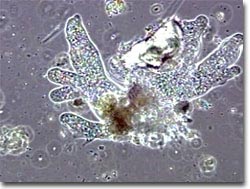
Staph bacteria. Picture courtesy of Janice Carr/CDC via BBC.
The question of which organisms are capable of undergoing habituation and sensitization is important, because these processes are regarded by psychologists as a form of learning, defined broadly as a relatively permanent modification in an organism's behaviour as a result of experience (Abramson, 1994, p. 2). Some researchers have claimed that habituation occurs in all cellular organisms, even bacteria (Di Primio, Muller and Lengeler, 2000, p. 7). Are these organisms capable of genuine habituation (i.e. "learning" as defined by psychologists), or is there some other, simpler explanation?
Case study: bacteria
The matter is discussed at length in an
Appendix. While the case is not closed, the available evidence points to the conclusion that bacteria are not capable of genuine habituation, but that their behaviour is better explained as an instance of sensory adaptation (a fixed pattern of behaviour, not to be confused with sensitization).
Case study: protoctista
The kingdom of protoctista includes organisms such as amoebae, algae, seaweeds, slime moulds, ciliates, diatoms, paramecia and forams. Unlike bacteria, protoctista are eukaryotes - organisms whose cells have a nucleus. They are described in more detail in an Appendix.
Certain kinds of protoctista (especially protozoa, such as paramecia and amoebae) are recognised as being capable of being properly habituated (Abramson, 1994, pp. 106, 112, 116, 117). This is an adaptive feat which bacteria appear to be incapable of. The evidence that protoctista are indeed capable of undergoing habituation is presented and described in an Appendix.
Case study: plants
The question of what makes a plant is dicussed at further length in an Appendix.
Most studies of plant learning have examined habituation in Mimosa, a small shrub whose leaves are sensitive to stimulation. There is reliable experimental evidence (see Appendix) that Mimosa plants are capable of habituation. In most of these cases, the habituation appears to be non-associative, although one intriguing apparent exception is discussed in detail. An experiment in 1965 showed that Mimosa could discriminate between different types of stimuli: it could be "trained" to stop closing in response to water droplets, but still retained its response to the touch of a finger. Clearly, more research needs to be done here.
Summary
We can now form a conclusion regarding the range of organisms that are capable of undergoing habituation and sensitization:


L.1 Habituation and sensitization appear to be confined to eukaryotes, or organisms with a nucleus in their cells.
Previous page - What are habituation and sensitization?
Next page - Should we call them "learning"?
*** SUMMARY of Conclusions reached
References